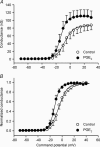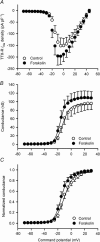Prostaglandin E2 potentiates a TTX-resistant sodium current in rat capsaicin-sensitive vagal pulmonary sensory neurones
- PMID: 15705651
- PMCID: PMC1464437
- DOI: 10.1113/jphysiol.2004.078725
Prostaglandin E2 potentiates a TTX-resistant sodium current in rat capsaicin-sensitive vagal pulmonary sensory neurones
Abstract
Capsaicin-sensitive vagal pulmonary neurones (pulmonary C neurones) play an important role in regulating airway function. During airway inflammation, the level of prostaglandin E(2) (PGE(2)) increases in the lungs and airways. PGE(2) has been shown to sensitize isolated pulmonary C neurones. The somatosensory correlate of the pulmonary C neurone, the small-diameter nociceptive neurone of the dorsal root ganglion, contains a high percentage of tetrodotoxin-resistant sodium currents (TTX-R I(Na)). Therefore, this study was carried out to determine whether these channel currents are involved in the PGE(2)-induced sensitization of pulmonary C neurones. We used the perforated patch-clamp technique to study the effects of PGE(2) on the TTX-R I(Na) in acutely cultured capsaicin-sensitive pulmonary neurones that were identified by retrograde labelling with a fluorescent tracer, DiI. We found that the pulmonary neurones sensitive to capsaicin had a higher percentage of TTX-R I(Na) than that of capsaicin-insensitive pulmonary neurones. PGE(2) exposure increased the evoked TTX-R I(Na) when experiments were performed at both room temperature and at 37 degrees C. Furthermore, stimulation of the adenylyl cyclase/protein kinase A pathway with either forskolin or Sp-5,6-DCl-cBiMPS potentiated the TTX-R I(Na) in a manner similar to that of PGE(2). We conclude that these modulatory effects of PGE(2) on TTX-R I(Na) play an important role in the sensitization of pulmonary C neurones.
Figures








Similar articles
-
Tetrodotoxin-sensitive and -resistant Na+ channel currents in subsets of small sensory neurons of rats.Brain Res. 2004 Dec 17;1029(2):251-8. doi: 10.1016/j.brainres.2004.09.051. Brain Res. 2004. PMID: 15542080
-
Capsaicin sensitivity and voltage-gated sodium currents in colon sensory neurons from rat dorsal root ganglia.Am J Physiol. 1999 Dec;277(6):G1180-8. doi: 10.1152/ajpgi.1999.277.6.G1180. Am J Physiol. 1999. PMID: 10600815
-
PGE(2) sensitizes cultured pulmonary vagal sensory neurons to chemical and electrical stimuli.J Appl Physiol (1985). 2002 Oct;93(4):1419-28. doi: 10.1152/japplphysiol.00382.2002. J Appl Physiol (1985). 2002. PMID: 12235043
-
Characterization of persistent TTX-R Na+ currents in physiological concentration of sodium in rat visceral afferents.Int J Biol Sci. 2009;5(3):293-7. doi: 10.7150/ijbs.5.293. Epub 2009 Apr 3. Int J Biol Sci. 2009. PMID: 19365577 Free PMC article.
-
Peripheral pain mechanisms.Curr Opin Neurobiol. 1997 Aug;7(4):493-9. doi: 10.1016/s0959-4388(97)80028-1. Curr Opin Neurobiol. 1997. PMID: 9287200 Review.
Cited by
-
Inflammatory mediators increase Nav1.9 current and excitability in nociceptors through a coincident detection mechanism.J Gen Physiol. 2008 Mar;131(3):211-25. doi: 10.1085/jgp.200709935. Epub 2008 Feb 11. J Gen Physiol. 2008. PMID: 18270172 Free PMC article.
-
Neural dysfunction following respiratory viral infection as a cause of chronic cough hypersensitivity.Pulm Pharmacol Ther. 2015 Aug;33:52-6. doi: 10.1016/j.pupt.2015.06.006. Epub 2015 Jun 30. Pulm Pharmacol Ther. 2015. PMID: 26141017 Free PMC article. Review.
-
Peripheral sensitization increases opioid receptor expression and activation by crotalphine in rats.PLoS One. 2014 Mar 4;9(3):e90576. doi: 10.1371/journal.pone.0090576. eCollection 2014. PLoS One. 2014. PMID: 24594607 Free PMC article.
-
Stimulatory effect of CO2 on vagal bronchopulmonary C-fiber afferents during airway inflammation.J Appl Physiol (1985). 2005 Nov;99(5):1704-11. doi: 10.1152/japplphysiol.00532.2005. Epub 2005 Jun 30. J Appl Physiol (1985). 2005. PMID: 15994240 Free PMC article.
-
Peripheral neural circuitry in cough.Curr Opin Pharmacol. 2015 Jun;22:9-17. doi: 10.1016/j.coph.2015.02.001. Epub 2015 Feb 19. Curr Opin Pharmacol. 2015. PMID: 25704498 Free PMC article. Review.
References
-
- Akaike N. Gramicidin perforated patch recording and intracellular chloride activity in excitable cells. Prog Biophys Mol Biol. 1996;65:251–264. 10.1016/S0079-6107(96)00013-2. - DOI - PubMed
-
- Akaike N, Harata N. Nystatin perforated patch recording and its applications to analyses of intracellular mechanisms. Jpn J Physiol. 1994;44:433–473. 10.2170/jjphysiol.44.433. - DOI - PubMed
-
- Akins PT, McCleskey EW. Characterization of potassium currents in adult rat sensory neurons and modulation by opioids and cyclic AMP. Neuroscience. 1993;56:759–769. 10.1016/0306-4522(93)90372-M. - DOI - PubMed
-
- Akopian AN, Sivilotti L, Wood JN. A tetrodotoxin-resistant voltage-gated sodium channel expressed by sensory neurons. Nature. 1996;379:257–262. 10.1038/379257a0. - DOI - PubMed
Publication types
MeSH terms
Substances
Grants and funding
LinkOut - more resources
Full Text Sources

